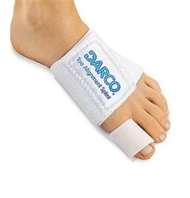Bunions, hammertoes, and neuromas are three of the most common
foot issues. Bunions, also known as hallux valgus, is more frequently
seen in women than men but common for both. Shoes that are ill-fitting
generally play a role in making this issue worse but do not usually
cause it. Usually bunions are inherited. Often a muscle imbalance will
increase over time and the deformity may change even with appropriate
shoes. Appropriate shoes have a wide toe-box, adequate length (approx. a
thumb thickness between the tip of the great toe and the end of the
shoe), and are deep enough shoe to accommodate for any toe deformities.
In addition to wearing different shoes, what else can be done for bunions?
Conservative
treatment for bunions is limited but there are several options that can
be somewhat helpful. Bunion splints can help to keep the great toe
apart from the second toe and can slow the need for surgery. Splints
can also be used to keep an elevated second toe down. The Darco splint is one that can help with both of these issues. Wearing this splint at night or while sitting around may provide enough relief to slow the need for surgery. A
cortisone injection into the joint may provide relief if there is an
inflammatory component to the bunion or some arthritis. Additionally, a
topical anti-inflammatory patch or gel may provide some relief. These
include Flector Patch, or Voltaren gel. Conservative treatment usually
only provides relief for a short period of time, but is certainly worth
trying prior to surgical intervention.
How much does bunion surgery hurt?
The
amount of pain that one will have from bunion surgery is highly
variable, but it is generally painful since bone work is often
performed. The medial bump is usually cut or chiseled away, and the
metatarsal bone is usually cut so as to reorient the great toe joint.
At times, the proximal phalanx of the great toe is cut as well. Bone
cuts are usually stabilized with screws or wires.
In
addition to the bone work that is done, there are many other things that
factor into the amount of pain one will experience. Some people are
naturally more sensitive to any type of stimulus which will make this
surgery more challenging. Also, individuals taking pain medicine,
anti-psychotics/anti-depressants, and sleeping pills will most likely
need much stronger medicine after surgery and may benefit from a pain
pump where local anesthesia is continually infiltrated around a large
nerve for 3-7 days after surgery by a very thin catheter.
How long does it take to heal?
Generally
the skin incision will heal in about 10-14 days, and the bone is healed
in 6 weeks. Most of the time you can walk immediately after bunion
surgery in a bandage and surgical shoe. The surgical shoe is usually
used for 2 weeks until the bandage is no longer needed. After 2 weeks
you can usually return to a sneaker or running shoe. After 6 weeks full
excercise is generally allowed. Full exercise means starting with a
very low impact activity like a stationary bicycle, then progressing to
more traumatic activity as tolerated. Running and jumping should be the
last activities attempted. You need to increase activity in a stepwise
fashion!
The soft tissue will take 3months to a year
to loosen up. The great toe joint will be stiff for quite some time.
If the incision is made dorsally (on the top of the joint), you will
often have difficulty flexing the great toe down for some time or
perhaps forever. With a medial based incision, you will not have this
difficulty and the scar will not be as visible. You may need two
separate incisions if it is done this way. The second incision would be
made in the webspace between the first and second toes to release a
tendon which may be necessary depending on the deformity.
What are the most common complications?
Bunion
surgery usually has a fairly high success rate but can be quite painful
as mentioned above. Infections can occur as with any
surgery... frequently a pre-operative antibiotic is administered. Wound
healing issues can occur, especially in smokers. Smoking affects all
small blood vessels which are critical for healing. Not only will the
skin and soft tissues have a much longer time healing or may not heal,
the bone work will take 50-100% longer to heal than in a non-smoker.
The bone work may even go on to a non-union (where it never bonds back
together as it is supposed to.). If you smoke, you should strongly
consider stopping completely at least 14-23 days before the surgery to
prevent these complications, or even not have the surgery. A smoker who
undergoes surgery is set up for failure or revision surgery.
There
are specific post-op instructions which need to be adhered to in order
to obtain the best result. There will be restrictions in the type of
foot wear needed (post-op shoe, sneakers, etc.), the amount of activity
you are allowed, bathing. These instructions are given so that the most
predictable and best outcome is obtained. If you deviate from these,
healing and positional issues will occur that will give you less than a
desired outcome or even beget revision surgery.
Often
the surgical site will be stiff for an extensive amount of time, up to
6-12 months. Full muscular strength after surgery usually takes 3-6
months. Although you are often able to bear weight immediately and
results are predictable, there is a significant healing phase and you
must be patient. The surgery usually takes 45-60 minutes but the healing
is the difficult part.


No comments:
Post a Comment